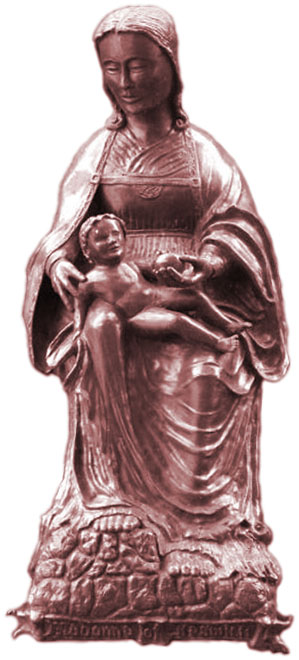- Screen Colours:
- Normal
- Black & Yellow
In the January 2022 Ipswich Society Newsletter [Issue 228] the article The shrine of Our Lady of Ipswich by Fr John Thackray referred to the medieval shrine and the establishment of the Guild of Our Lady of Grace in 1977. I am now the only person left around who was at the very first meeting which led to the formation of that Guild.
Stanley Smith, a parishioner of St Pancras Church in Tacket Street, took a large group from Ipswich on a pilgrimage to Rome in 1975. He had been researching the origins of the Ipswich shrine, leading to the publication of his book, The Madonna of Ipswich (now out of print). We cannot know whether he or John Blatchly was correct. However, Stanley believed that because the Nettuno statue had a silver shoe, as did the Ipswich one, and had an inscription which could only make sense if it said ‘Thou art gracious’ in old English (hence Our Lady of Grace) it was likely to be authentic. Thus, his pilgrims spent a day in Nettuno, Italy, where they were given a wonderful civic reception and taken to the church where the statue now resides.
One of the pilgrims was Dr Maire Heley, another St Pancras parishioner, well known to many in the town as the senior partner of the Woodbridge Road medical practice. She was clearly impressed by the Nettuno visit; in July 1977 she and Stanley called a meeting at her home of a few local Anglicans and Catholics. I was one of them. Their aim was to pray for Christian unity and to re-establish the shrine. We were all very enthusiastic and the Guild was soon established. In those days it was totally lay led, not only by Anglicans and Catholics but soon joined also by Methodists.
 The big event was on 8 September 1978, a ‘pilgrimage walk’ starting near to Wolsey’s Gate and going through the town to Lady Lane, where the shrine once stood. It was 450 years to the day after the walk planned by Cardinal Wolsey along that exact route from his college to the shrine; in fact, they had a rehearsal on 7 September but the 8 September was ‘a day of foul weather’ and it did not take place. We have walked that route every year since and have never been rained off!
The big event was on 8 September 1978, a ‘pilgrimage walk’ starting near to Wolsey’s Gate and going through the town to Lady Lane, where the shrine once stood. It was 450 years to the day after the walk planned by Cardinal Wolsey along that exact route from his college to the shrine; in fact, they had a rehearsal on 7 September but the 8 September was ‘a day of foul weather’ and it did not take place. We have walked that route every year since and have never been rained off!
Much more mundane activities in those days focused both on ecumenism and concern for the sick. Our Lady’s Clock allowed members to choose a time, even in the middle of the night, when they would pray the Guild Prayer (which Dr Heley and I composed) for unity of Christians and devotion to Mary, Our Lady of Grace. Small groups visited the sick or housebound monthly, to pray with them. A quarterly magazine had a variety of articles with contributors from a wide range of churchmanship. Much more ambitious were pilgrimages to Nettuno in May around the Feast Day of The English Lady (i.e. the statue they believe came from Ipswich). These included huge processions with the statue, endless courses of delicious food and terrific firework displays. We even took a group of Ipswich primary children one year.
As time went by, initial members died (including Stanley) but activities remained, with Dr Heley always a key figure. Her funeral, on the second day of the first lockdown, marked the end of an era. We are now re-emerging with a new team and invite readers to our celebration of twenty years since our own statue was installed in St Mary Elms church. Just as on that day, at the service at 11am on 26 March there will be representatives not only from a variety of Christian traditions but also from the Muslim community. Details of a variety of imaginative activities to take place over the next year will be revealed on that day.
Jean M. Johnson
Photograph: sculpture in Lady Lane by Robert Mellamphy